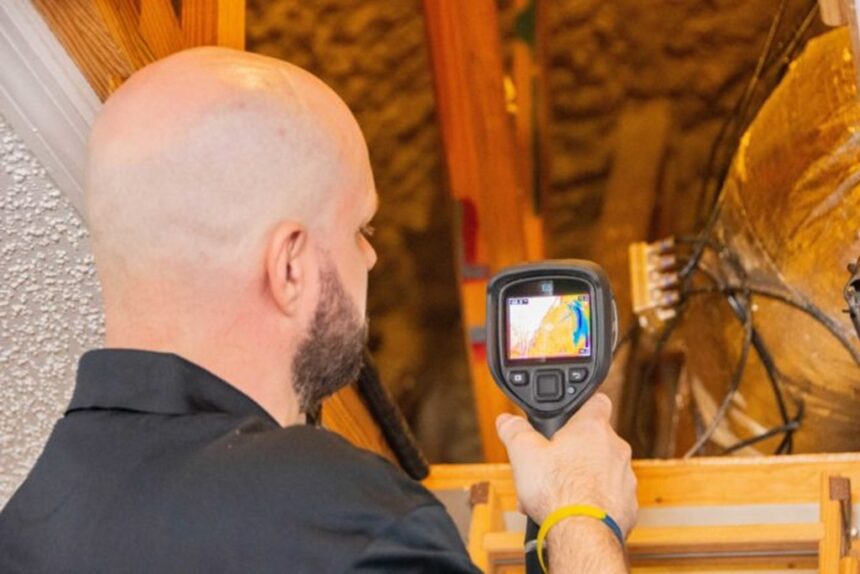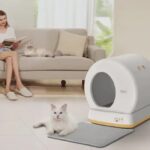It is not possible in building diagnosis and maintenance to observe everything with naked eyes. That is where infrared surveys come in—a sophisticated, non-destructive method that peers behind walls, floors, and ceilings to detect hidden problems using thermal imaging.
Whether you’re an owner-occupier, property manager, or industrial engineer, infrared surveys yield valuable information on energy efficiency, water ingress, electrical failure, and structural defects—all without the removal of a single roof tile.
As we go through this article, we will discuss what an infrared survey is, how it’s conducted, and why it’s the method of choice for property diagnosis in this modern age.
What Is an Infrared Survey?
Infrared thermography, also known as thermal imaging surveying, is the practice of using infrared cameras to track changes in temperature on a surface. Infrared camera images can make surface temperature differences become very pronounced and show underlying problems like heat loss, leakage, or overload in electrical circuits.
Thermal cameras detect infrared radiation (heat) from objects and convert the data into a colour map called a thermogram. Red or yellow can be used to represent warmer regions, and blue or purple can be used to represent cooler regions. The images allow practitioners to detect conditions that cannot be detected by visual inspections.
How Does It Work?
Infrared cameras require no surface contact or penetration of materials. They scan temperatures and display them graphically. The process typically includes:
- Surfacing scanning of the equipment, ceiling, floors, and walls using an infrared camera
- Recording of thermographic images
- Checkup on abnormalities like unusual hot or cold spots
- Preparation of a report with conclusions and recommendations in detail
Infrared surveys are easily carried out, usually with minimal or no disruption to the property.
Where are Infrared Surveys Used?
Infrared surveys have widespread application across a number of industries:
a. Domestic Houses
Heat loss and insulation deficiency detection
Detection of water or damp behind walls
Verification of underfloor heating installations
Detection of rodent nests behind walls (using heat signature)
b. Office Buildings
Performance testing of HVAC systems
Energy auditing for efficiency
Mould and structural damage prevention
c. Industrial Plants
Temperature monitoring of electrical panels and overheating equipment
Prevention of machinery failure
Compliance with safety
d. Building and Refurbishment
Verification of insulation correct installation
Detection of structural weakness
Wet roof or cladding guarantee
Principal Benefits of Infrared Surveys
Infrared surveys have several principal benefits:
a. Non-Invasive
No tearing ceilings and walls apart. The surveys are conducted from the outside and will not devastate everything.
b. Early Detection
Detect problems in advance, before they are apparent or have had a chance to cause costly damage, and save money and time.
c. Greater Efficiency
a. Cost Savings
The exact problem is identified by the technicians so that they can fix problems faster and more efficiently.
d. Energy Savings
Infrared inspections show where the heat loss is taking place, so that there can be fewer heating bills as well as less carbon emissions.
e. Health and Safety
Respiratory issues are the result of mould and dampness. Detection of dampness early on means a healthier environment.
f. Certification and Compliance
Commercial properties usually use infrared reports in an attempt to comply with energy performance and safety regulations.
Common Problems Revealed By Infrared Surveys
Infrared scanning detects:
- Insufficient insulation in the walls, roof, or loft
- Leaking vents, doors, and windows
- Dampness or moisture in the building frames
- Overloaded electrical circuits or hotspot wiring
- Blocked pipes or ineffective heating systems
- Unseen eye-blind roof leaks in your flat roof
These are issues that, if not addressed, will lead to costly repairs, energy losses, or fire hazards.
Who Should Listen to an Infrared Survey?
If you belong to one of the groups mentioned below, an infrared survey would be worth your while:
Homebuyers: Ensure that the home you are purchasing is issue-free and energy efficient behind the walls.
Landlords & property managers: Save on repair expenses and prevent tenant disagreements by detecting them prior to their occurrence.
Business owners: Lower insurance risk expenses, protect your property, and reduce energy bills.
Construction companies: Confirm that the quality of the new construction is as required at handover.
Facility managers: Maintain optimum equipment and facility uptime with a minimum of downtime.
The Infrared Survey Process: What to Expect
The survey will typically be a straightforward, easy process:
Initial consultation to establish the reason for the inspection
High-resolution infrared scanning of the property using cameras
Interpretation of anomalies through image analysis
Comprehensive report with results data, including thermographic images
Repair, upgrade, or second-stage tests are recommended
Depending on the equipment or property size to surveyed, the entire survey takes a couple of hours.
Points to Ponder and Limitations
Infrared surveys are effective, but like all other testing methods, there are some limitations:
Surface conditions matter: Wet or shiny surfaces can ruin accuracy.
Training matters: Successful inspection relies on skilled thermographers.
Environmental conditions: Sunlight, rain, or wind may influence readings.
It is not X-ray vision: Surveys only detect surface temperature variations, not hidden objects.
That’s why it’s so vital to choose a qualified provider with experience in your specific industry in order to obtain accurate, usable results.
Conclusion: Peering Beneath the Surface
Infrared scans uncover hidden problems. They enable homebuyers, businesses, and engineers to make informed decisions, repair defects, and protect investments—before damage even occurs.
In a world where safety, energy efficiency, and preventive maintenance are more important than ever, infrared surveys offer an edge that’s as potent as it is effective. Whether you’re preventing expensive future breakdowns or charting a smart remodel, this technology offers a level of insight into your property without ever having to open a single wall.














